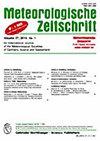Evaluation of compact hygrometers for continuous airborne measurements
IF 1.7
4区 地球科学
Q4 METEOROLOGY & ATMOSPHERIC SCIENCES
引用次数: 0
Abstract
Continuous water vapour measurements in the troposphere and lowermost stratosphere are crucial for the understanding of global water transport processes and climate impact. In the course of the ‘Development and Evaluation of Novel and Compact Hygrometer for Airborne Research’ (DENCHAR) project, water vapour instruments (WaSuL, WVSS‑II, ICH) have been partly newly developed and/or extensively tested in the laboratory as well as onboard of research aircraft. For the blind intercomparisons of the instruments, an MBW DP30 frostpoint mirror and the established FISH Lyman‑α instrument (calibrated versus the MBW DP30) served as reference hygrometers in the laboratory and during the flights, respectively. All DENCHAR-instruments show very consistent behaviour in their respective measuring ranges with deviations of less than about 5–10 %, in‑flight with respect to FISH and in the laboratory with respect to DP30 in the range between 100 and 1000 ppmv, as well as among each other in the range of 100 to 20000 ppmv. At mixing ratios below 100 ppmv, differences between the instruments appear which depend on the individual response times and calibrations. In summary, the WaSul, ICH and WVSS‑II hygrometers can be recommended for continuous water vapour measurements at mixing ratios larger than 10, 30, and 30 ppmv, respectively. For an accurate, reliable, and stable measurement of lower water vapour mixing ratios with a compact hygrometer suitable for autonomous operation, either these instruments need to be improved or new technology would have to be developed. In addition to the instrument evaluation, the performance of different water vapour inlet systems is addressed by comparing a forward-facing Rosemount (TAT housing) and a wall plate inlet. From all in‑flight tests, no measurement artifacts caused by specific characteristics of an inlet could be identified, i.e., forward-facing Rosemount and wall plate inlets can be recommended for use on aircraft for water vapour mixing ratios above 30 ppmv.评估用于机载连续测量的紧凑型湿度计
对流层和最下层平流层的连续水蒸气测量对于了解全球水输送过程和气候影响至关重要。在 "机载研究用新型和紧凑型湿度计的开发和评估"(DENCHAR)项目过程中,部分水蒸气仪器(WaSuL、WVSS-II、ICH)得到了新开发和/或在实验室和研究飞机上得到了广泛测试。为了对仪器进行盲比,在实验室和飞行过程中分别使用了 MBW DP30 霜点镜和现有的 FISH Lyman-α 仪器(根据 MBW DP30 进行了校准)作为参考湿度计。所有 DENCHAR 仪器在各自的测量范围内均表现出非常一致的性能,偏差小于约 5-10%,在飞行中与 FISH 相比,在实验室中与 DP30 相比,偏差范围在 100 至 1000 ppmv 之间,相互之间的偏差范围在 100 至 20000 ppmv 之间。当混合比低于 100 ppmv 时,仪器之间会出现差异,这取决于各自的响应时间和校准。总之,WaSul、ICH 和 WVSS-II 湿度计可分别用于混合比大于 10、30 和 30 ppmv 的连续水蒸气测量。若要使用适合自主操作的紧凑型湿度计对较低的水蒸气混合比进行准确、可靠和稳定的测量,则需要对这些仪器进行改进或开发新的技术。除了对仪器进行评估外,还通过比较前向罗斯蒙特(TAT 外壳)和壁板式入口,对不同水蒸气入口系统的性能进行了研究。在所有飞行测试中,均未发现因进气口的特定特性而导致的测量伪影,即建议在飞机上使用前向罗斯蒙特和壁板进气口来测量混合比超过 30 ppmv 的水蒸气。
本文章由计算机程序翻译,如有差异,请以英文原文为准。
求助全文
约1分钟内获得全文
求助全文
来源期刊

Meteorologische Zeitschrift
地学-气象与大气科学
CiteScore
2.80
自引率
8.30%
发文量
19
审稿时长
6-12 weeks
期刊介绍:
Meteorologische Zeitschrift (Contributions to Atmospheric Sciences) accepts high-quality, English language, double peer-reviewed manuscripts on all aspects of observational, theoretical and computational research on the entire field of meteorology and atmospheric physics, including climatology. Manuscripts from applied sectors such as, e.g., Environmental Meteorology or Energy Meteorology are particularly welcome.
Meteorologische Zeitschrift (Contributions to Atmospheric Sciences) represents a natural forum for the meteorological community of Central Europe and worldwide.
 求助内容:
求助内容: 应助结果提醒方式:
应助结果提醒方式:


